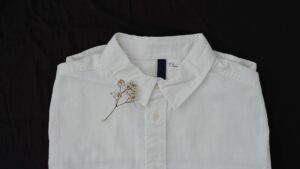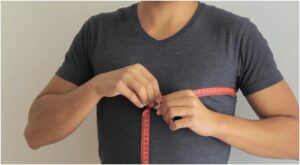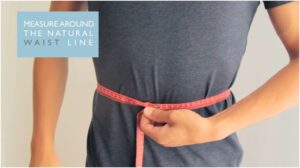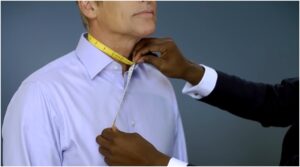
Ever stood in front of your wardrobe, staring at a shirt, and wondered if it’s going to fit like a glove or leave you feeling like you’re stuffed into a too-tight box? Been there.
One of my favorite (and slightly embarrassing) experiences was when I bought a gorgeous shirt online, convinced it would fit perfectly. When it arrived, I looked like a kid trying to wear an adult’s hand-me-down.
The sizing seemed so off, but it wasn’t the shirt’s fault — it was a classic case of me misunderstanding the shirt size chart!
Let’s be real: understanding a shirt size chart is crucial, and if you’ve ever found yourself confused between S, M, L, or XL, you’re not alone.
With varying measurements, sizing systems across brands, and the added challenge of regional differences, it’s no wonder we’re all left scratching our heads.
But fear not, I’m here to guide you through it and help you make sure that next time, the shirt you choose fits like it was made for you.
What’s the Deal with Shirt Size Chart?

When you shop for clothes, shirt size charts are your secret weapon. They give you precise measurements to ensure you don’t end up with something too big or too small. But the thing is, they’re not all the same.
Each brand has its own take on sizing — one might run a little small, another a bit larger — but they generally follow a similar pattern.
For men, the typical shirt size chart considers chest, neck, and sleeve length. Here’s a general look at what you’ll typically find:
| Size | Chest (Inches) | Neck (Inches) |
| S | 36-38 | 15.5 |
| M | 38-40 | 16 |
| L | 40-42 | 17 |
| XL | 42-44 | 17.5 |
| XXL | 44-46 | 18.5 |
Now, here’s the thing to keep in mind: neck size refers to the measurement around the base of your neck where the collar would sit. A lot of the time, you’ll see this paired with chest measurements to ensure a more fitted look.
How Do Women’s Shirt Sizes Differ from Men’s?

When it comes to women’s shirts, the sizing chart usually revolves around bust, waist, and sometimes hip measurements. This chart will help you get a good fit for tops, blouses, and T-shirts:
| Size | Bust (Inches) | Waist (Inches) |
| S | 34-36 | 28-29 |
| M | 36-38 | 30-32 |
| L | 38-40 | 32-34 |
| XL | 40-42 | 34-36 |
| XXL | 42-44 | 36-38 |
But let’s talk about that one frustrating part: Is L size 40 or 42? Well, the answer depends on the brand, but generally, an L size tends to cover a range from 40 to 42 inches in bust measurement. So if you’re somewhere in between, an L could be your go-to.
How to Measure Yourself for a Perfect Shirt Fit

So how do you figure out which size is your size? A simple measuring tape and a few minutes of your time will save you from the dreaded return process.
- Chest: Measure around the fullest part of your chest, keeping the tape comfortably under your arms. This will give you the best idea of your chest size.
 Image source- Silkstaq
Image source- Silkstaq - Waist: For shirts that sit at the waist, measure around the narrowest part of your waist. For a more relaxed fit, you can measure around your natural waistline.

- Neck: If you’re dealing with collared shirts, measure around the base of your neck where the collar would sit.
 Image source-Charles Tyrwhitt
Image source-Charles Tyrwhitt - Sleeve Length: Measure from the center of your back, across your shoulder, and down to your wrist bone. This will give you an accurate sleeve length, especially for dress shirts or button-downs.

If you’re in between sizes, my advice is to always choose the larger one — it’s better to have a bit more room than too little.
How Do Shirt Sizes Vary Between Regions?

Depending on where you live or where you’re buying from, shirt sizes can vary drastically.
For example, in the U.S., you might see shirts labeled as S, M, L, and XL, but if you’re in Europe, the sizing could be slightly different, often using numerical measurements (like 38, 40, 42).
If you’re buying shirts online from international brands, you might find a size guide in both U.S. and European measurements.
A great example: A U.S. size L shirt could correspond to a European 42 or 44, depending on the brand. So if you’re in doubt, always check the sizing guide!
Is 32 a Size S or M?
If you’re referring to chest size, 32 inches typically falls under size S. However, when it comes to women’s shirts, a 32-inch bust is often considered the lower end of the size range for M. So, yes, a 32 bust could be either depending on the cut of the shirt and the brand’s sizing standards.
What’s the Deal with 42 cm in Shirt Size?
You might have encountered shirts labeled with neck measurements in centimeters, like 42 cm. When converted, 42 cm roughly equals 16.5 inches, which would correspond to a neck size of 16.5 — or a men’s shirt size M or L depending on the chest measurement.
It’s always a good idea to refer to the brand’s specific size chart, as their interpretation of “M” and “L” may differ slightly.
Your Frequently Asked Questions: Shirt Size Edition
Q: What is the size for a 42 chest?
A: A 42-inch chest generally fits into a L or XL, depending on your body shape and the fit you’re aiming for. A regular fit might lean toward L, while slim fits could lean toward XL for a more relaxed look.
Q: Is L a size 40 or 42?
A: Size L can vary between 40 to 42 inches in chest measurement, so it’s right in the middle. Some brands may lean toward 40, while others stretch a bit into the 42 range.
Q: How do I know if I should go up or down a size?
A: If you’re in between sizes, I recommend going up a size for a more comfortable, looser fit. For a more tailored look, you could try a smaller size, but keep in mind that you might end up with a shirt that’s a bit too snug.
Q: What size is 42 cm in neck size?
A: A 42 cm neck size equals approximately 16.5 inches, typically fitting into a size M or L, depending on the brand and the chest measurements provided.
Fit, Fashion, and Fun: The Ultimate Shirt Size Tip
Shirt shopping can be overwhelming, but it’s all about knowing your measurements, understanding the brand’s fit, and being patient when finding your perfect shirt.
The key takeaway? Don’t just settle for the first thing you pick up. With a little measurement know-how and the perfect size chart, you’ll never have to worry about buying the wrong fit again.
Whether it’s a T-shirt, a button-down, or a chic blouse, a great fit makes all the difference. Happy shopping, my friends!



